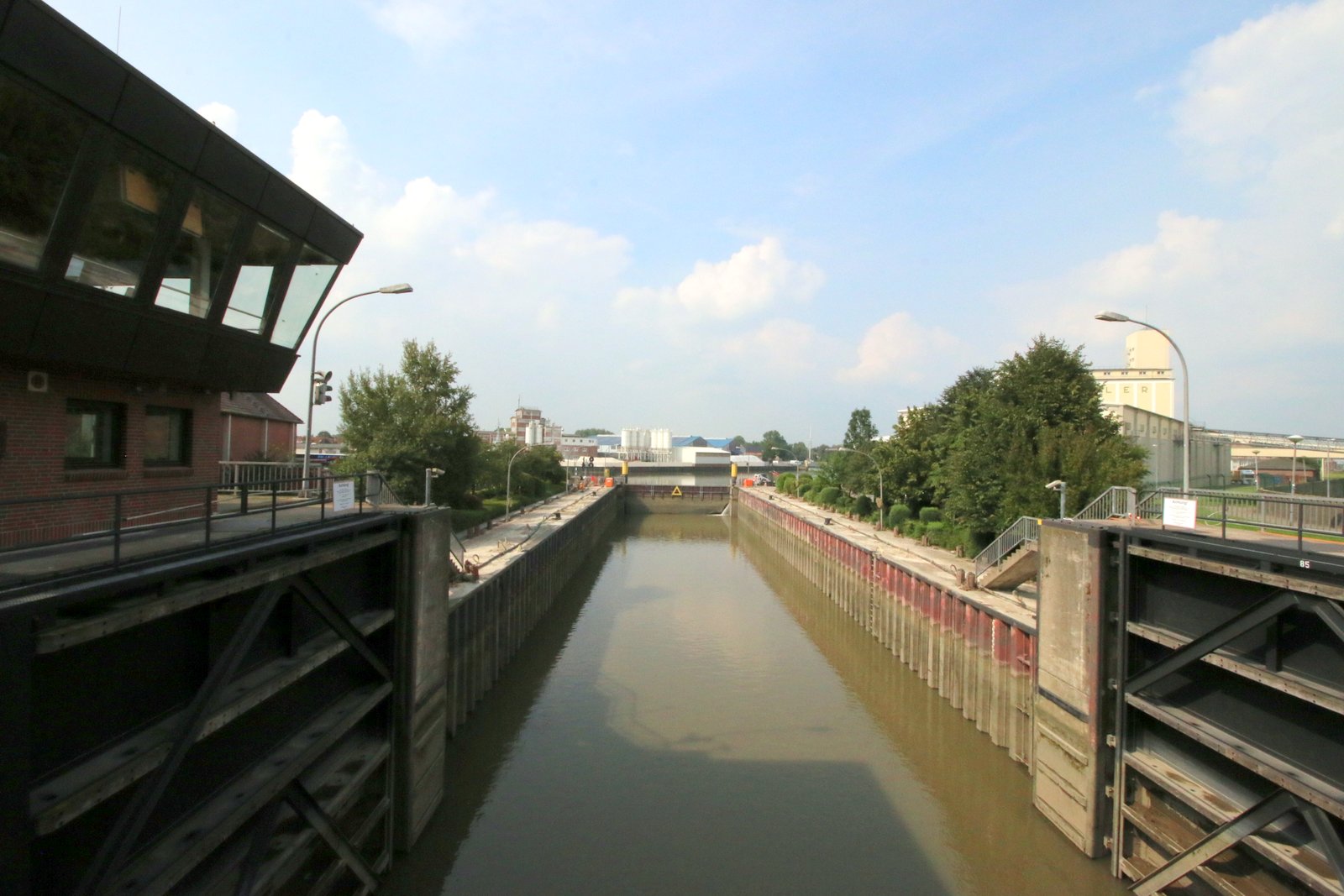
Bewerten
230c35bf-bfeb-4861-b362-286cde09d128|0|.0|96d5b379-7e1d-4dac-a6ba-1e50db561b04
The floodgate lock of Brake connects the sea harbor – the Stromkajen – to the inland harbor. In the past, this very point served as the entry into the “Braksiel”, which was utilized as a protected moorage for small vessels, prior to its subsequent use as an expanded harbor basin. Already as early as the beginning of the 19th century, the space for mooring was extraordinarily limited, given that the ships of the Imperial Navy overwintered here. On the 29th of October 1861, the first ship passed through the floodgate in Brake. In 1980, the facility was modernized to serve as a chamber lock independent of the tides and with the ability to protect against storm surges.
A necessary Investment
 Brake outer harbor around 1900
In the 1850s, the dehydration of the Braker Siel was supposed to have been improved. A plan dating back to 1855 called for relocating the previous sluice and complementing the harbor in the outer area with a lock. The necessary sluice came into being during the harbor expansion in 1860. On the 29th of October 1861, prior to the official opening, the first ship entered into the harbor via the new sluice. Within a few months, nearly all of the maritime traffic in Brake involved the sluice harbor.
Brake outer harbor around 1900
In the 1850s, the dehydration of the Braker Siel was supposed to have been improved. A plan dating back to 1855 called for relocating the previous sluice and complementing the harbor in the outer area with a lock. The necessary sluice came into being during the harbor expansion in 1860. On the 29th of October 1861, prior to the official opening, the first ship entered into the harbor via the new sluice. Within a few months, nearly all of the maritime traffic in Brake involved the sluice harbor.
From the Dock Gate to the Chamber Lock
The first sluice remained in operation for nearly 120 years. Under normal high water conditions, ships having a maximal draft of 5.5 meters were able to pass through the sluice. In 1892, a pier was built along the open river. The water was deeper at that location, allowing vessels with deeper drafts to moor. Furthermore, six berths were located along the shore, these were leased to the companies J. Müller und Karl Gross.
 Power plant and lock
Power plant and lock
around 1900
The first sluice was a simple dock lock, typical of the 19th century. The omission of a lock chamber enabled the facilities to save space and money, however, tide-dependent sea harbors such as Brake could engage in locking only during periods of equivalent water levels in front of and behind the lock gates. The window of opportunity therefor hardly amounted to an hour and was thus very small. From 1978 until 1980, the Land of Lower Saxony permitted the renewal of the sluice of the inland harbor during the course implementing increased measures aimed at protecting against high water, and this move was aimed at preventing the dyke from breaking during a storm surge. At the time, the old dock gate gave way to a tide-independent chamber lock with a length of 95 meters, a breadth of 16 meters and a depth of 6 meters. A sliding gate is located both in the inner and the outer heads. A pair of mitering gates in the outer area serves as a means of secondary dyke safety. Deeply embedded, closeable flood protection walls, control units and mooring dolphins “Duckdalben” [LINK] are located along the gate. The costs of the project amounte to 22 million German Marks (DM).
The Lock today
Employees of the building yard of Brake, a branch office of the Waterways and Shipping Office of Bremen, ensure that the facility functions smoothly. Ships measuring up to 90 meters in length, having 5.5 meters of draft and with capacities of up to 3,000 tons deadweight can pass through the sea sluice at any time. Regular sluice operation times begin at 9 h in the morning on the weekend for every two hours up until 19 h, and weekdays upon consultation with the Harbor Office.
Moreover, pedestrians and cyclists can use the facility to comfortably pass between the inland harbor to the other side. Additionally, a section of the Weser Bicycle Path parallels the sluice.
Experiences in the museum
The development of Brake’s harbor and along with it the development of Brake is the topic at several places in the MAritime Museum of the Oldenburgian Lower Weser. A good view of the harbor area can be found at the top floor of the Telegraph.
You can find more information on the harbor at the "Brake Harbor" station.
Maritime Museum - Telegraph, Kaje 8, 26919 Brake - 5th floor
Brake Harbor, Am Binnenhafen, 26919 Brake
